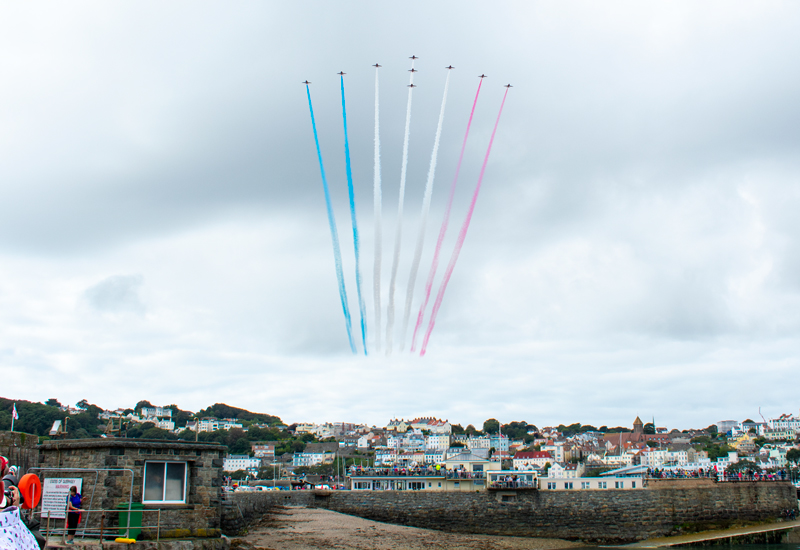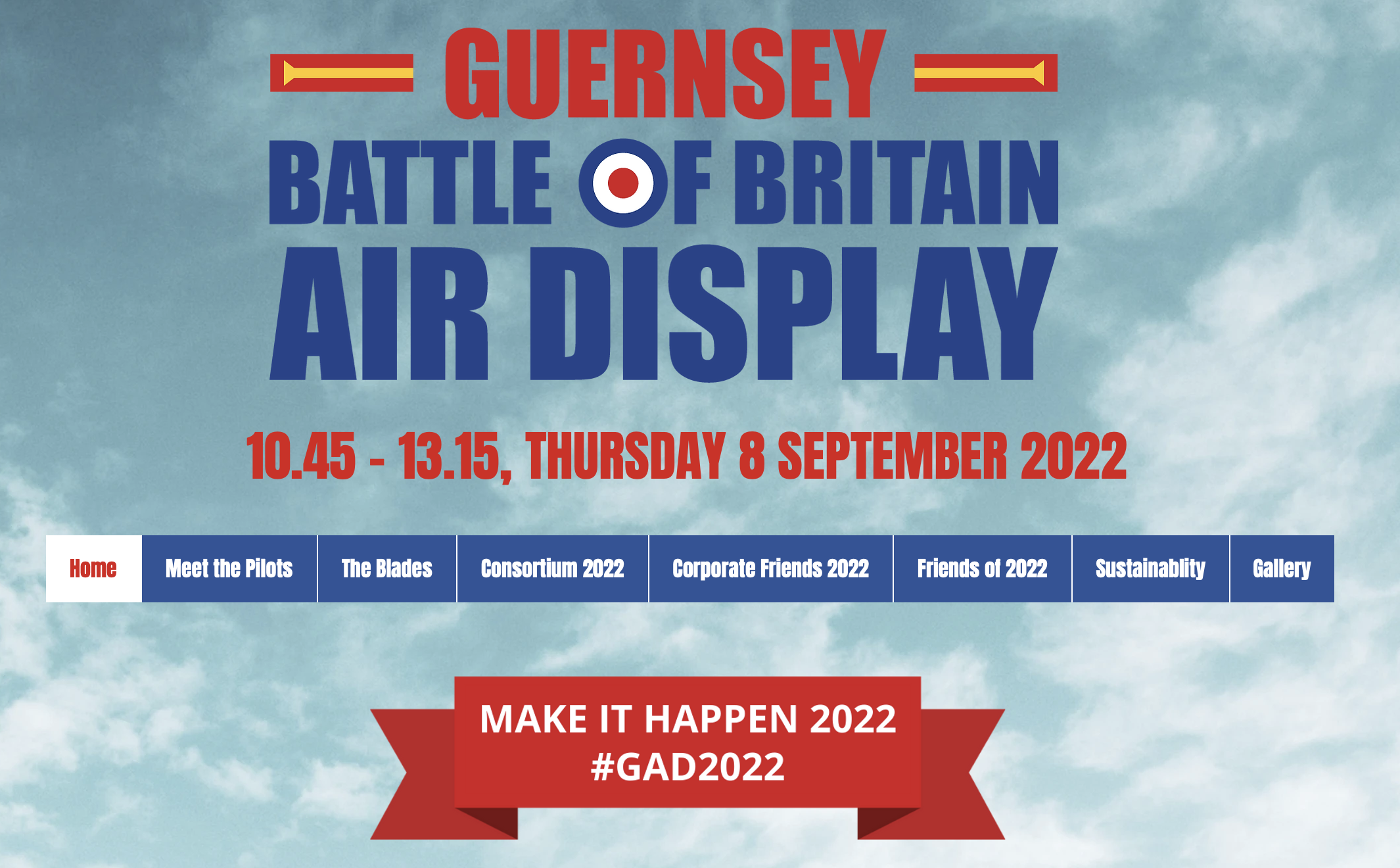


Guernsey's 2022 Air Display will take place above St Peter Port Harbour today, with the Battle of Britain Memorial Flight, a Chinook, an OV-10 Bronco and others flying overhead.
The show is scheduled to start at 11:20 and close at 13:15, with the Red Arrows performing the final display.
The date of this year's Air Display clashes with the return to school day for most island pupils.
A spokesman for Education yesterday confirmed that individual head teachers will communicate arrangements for parents to take pupils out of class to watch the show.

Pictured: Guernsey schools welcome students for the first day of term today - but many may be absent for a while as they go to watch the 2022 Air Display.
The date of the 2022 Air Display is also the same day that a large cruise ship was due to dock outside St Peter Port Harbour. That visit was cancelled, meaning the Albert Pier is open for car parking as usual, despite prior warnings to the contrary.
As in previous years it is expected that people will watch the Air Display from all locations along the east coast, including St Martin's point, the St Peter Port sea front and St Sampson's coastal areas as well as Delancey Park.

Pictured: People watched the 2021 display from many vantage points including the Castle Emplacement and Yacht Club.
The full line up of aircraft due to take part in the 2020 Guernsey Air Display is:

Pictured: The 2022 running order can be found at guernseyairdisplay.com All appearances and the timings of each are subject to change.
Battle of Britain Memorial Flight (BBMF)
The Battle of Britain Memorial Flight was inaugurated on 11 July 1957 at RAF Biggin Hill. It was originally called the RAF Historic Aircraft Flight and consisted of three PR Mk XIX Spitfires and the RAF’s last airworthy Hurricane, LF363. It was then renamed to be the Battle of Britain Memorial Flight before a final renaming in 1969 to what it is known as today, BBMF.
Between 1959 and 1965 the flight had one Spitfire (PM613) and one Hurricane (LF363) on its strength. Now, as a ‘museum without walls’, it maintains 12 historic and irreplaceable aircraft: an Avro Lancaster, a C-47 Dakota, six Spitfires, two Hurricanes and two de Havilland Chipmunk training aircraft. The BBMF is a regular RAF unit, manned by service personnel and funded by the Ministry of Defence.
Battle of Britain Memorial Flight | Royal Air Force (mod.uk)
Navy Wings Seafire
The Supermarine Seafire was a naval version of the Supermarine Spitfire adapted to become a high performance carrier-based fighter aircraft.
Seafire XVII SX336 was built just 15 miles from the Navy Wings heritage hangar by Westland, Yeovil in April 1946 and rebuilt by Kennet Aviation at North Weald nearly 60 years later. It was decided she should be scrapped in 1955 but it wasn’t until 1973 that her fuselage was discovered in a derelict state and another five years before her restoration began. Ownership of the aircraft changed hands several times and it was only in the ownership of former US Navy pilot and entrepreneur Tim Manna that she was finally rebuilt and restored to full flying condition.
Seafire SX336 - Navy Wings - Naval Aviation Charity
Navy Wings Wasp
The Westland Wasp HAS1 is a first-generation jet engine helicopter that was built for the Royal Navy, based on an original Saunders Roe concept of a light utility helicopter for the British Army – the Scout AH1. The army Scout was configured as a light five-seat helicopter with skid undercarriage, whereas the Wasp has a quadricycle undercarriage, with fully castoring, long-stroke oleos and lockable wheels that can be toed outwards or inwards depending on operational need.
The Navy Wings Wasp XT420 was built in 1964 and at various times served with 706 Naval Air Squadron (training) and the following ships’ flights of 829 Naval Air Squadron: HMS Nubian, HMS Hecate, HMS Aurora and HMS Ajax. She also served with HMS Hecla (Falklands), with red crosses painted on in a casualty evacuation role. She was disposed of by the Royal Navy in April 1994.
Wasp HAS Mk1 XT420 - Navy Wings
OV-10 Bronco
The OV-10 Bronco, a rugged, manoeuvrable, twin-turboprop, multi-mission aircraft, served with the US Air Force (USAF) and Marine Corps. In military operations, the Bronco’s ability to find and hit battlefield targets close to friendly troops made it effective against conventional and guerrilla forces.
The first production OV-10A was ordered in 1966, and its initial flight took place in August 1967. The Bronco's missions included observation, forward air control, helicopter escort, armed reconnaissance, gunfire spotting, utility and limited ground attack. The USAF, however, acquired the Bronco primarily as a forward air control (FAC) aircraft. Adding to its versatility is a rear fuselage compartment with a capacity of 3,200 pounds of cargo, five combat-equipped troops or two litter patients and a medical attendant. The first USAF OV-10As destined for combat arrived in Vietnam in July 1968 and a total of 157 OV-10As were delivered to them before production ended in April 1969.
RAF Chinook
The Chinook is an extremely capable and versatile support helicopter, primarily used for trooping, resupply and battlefield casualty evacuation. The aircraft may be heavily armed and is fitted with a suite of self-defence equipment, allowing it to operate across highly contested battlespace. With its triple-hook external load system, internal cargo winch, roller conveyor fit and large power reserves, the aircraft can lift a wide variety of complex underslung or internal freight, including vehicles. It can carry up to 55 troops or approximately 10 tonnes of mixed cargo.
Secondary roles include search and rescue and supporting a wide variety of specialist tasks, including the Military Aid to the Civil Authorities commitment. A Chinook crew comprises two pilots and two crewmen, supplemented by specialists dependent upon mission requirements.
Chinook Display Team | Royal Air Force (mod.uk)
Royal Air Force Aerobatic Team - The Red Arrows
The Royal Air Force Aerobatic Team, the Red Arrows, is one of the world’s premier aerobatic display teams. Representing the speed, agility and precision of the Royal Air Force, the team is the public face of the service and assists in recruiting to the Armed Forces, as well as acting as ambassadors for the UK at home and overseas to promote the best of British.
Flying distinctive Hawk fast-jets, the team comprises pilots, engineers and essential support staff with frontline operational experience. With their trademark shapes and combinations of close formations and precision flying, the Red Arrows have been displaying since 1965.
All Red Arrows display pilots have flown operationally, in frontline aircraft such as the advanced Typhoon. Based at RAF Scampton in Lincolnshire, the Red Arrows had flown 5,000 displays in 57 countries by the beginning of 2022, the team’s 58th season.
Red Arrows | Royal Air Force (mod.uk)
Rich Goodwin - Muscle Biplane
Rich Goodwin’s unique Pitts S2S has symmetrical wings and four symmetrical ailerons with spades on the lower set to help reduce stick force in a roll. The six-cylinder engine has more of a growl than its predecessors, enabling the S2S to draw longer vertical lines than its smaller brothers and sisters.
It is also capable of spectacular tumbles and a different style of high-energy aerobatics. The Muscle Biplanes have become iconic aerial entertainers with many improvements and modifications made over the years and have entertained at air shows around the world. The Biplane gets its strength from the box-like structure of the top and bottom wings, connected by diagonal steel wires to make it rigid.
https://www.richgoodwinairshows.com/muscle-biplanes
Team Raven
Team Raven is a formation aerobatic display team that was established in May 2014. The name came from a play on the letters ‘RV’ and makes more sense if written ‘RaVen’ as per the badge on the sides of the six aircraft fuselages. The RaVens use the Van’s RV aircraft.
The RV-8 retains the fighter-like feel of centre-line seating, making it perfect for formation flying. The efficient airframe provides long-range and high cruise speeds, so long distances can be covered easily. The aircraft has a fuel capacity of 170 litres and can achieve a maximum speed of 220mph. The speed and the excellent climb rate provide options for dealing with weather and terrain that are not available to most pilots.
The Blades
Undertaking aerobatic manoeuvres less than four metres apart in perfect formation, executing high-speed synchronised passes and extreme gyroscopic aerobatics, the team has won international accolades with their cutting-edge displays. The pilots fly the Extra 300, a low-wing, high-performance aircraft, and have performed over 1,000 displays worldwide since forming 15 years ago.
The Blades are a world-class formation display team made up of highly skilled former Red Arrows pilots, and are the only aerobatic airline to fly passengers in formation. Their aim is to provide an unparalleled and thrilling flying experience to anyone looking for an incredible and highly memorable day. The aircraft offers an amazing opportunity to experience the exciting and unique sensation of close formation flying and aerobatics.
Pictured top: The 2021 Guernsey Air Display.
Comments
Comments on this story express the views of the commentator only, not Bailiwick Publishing. We are unable to guarantee the accuracy of any of those comments.